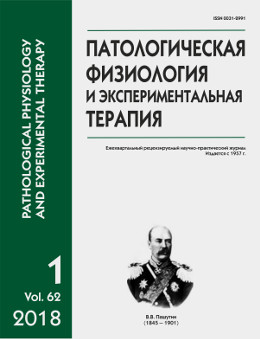Chronic periodic cold exposure had no affect the blood pressure and stability of heart to action ischemia and reperfusion
Abstract
Purpose: to investigate the periodic effect of cold on rats of Wistar males. Methods: the studies were conducted using two protocols (8 h, +4 оС, 4 weeks) and (1.5 h, +4 оС, 4 weeks). Ischemia (45 min) was modeled by ligation of the left descending coronary artery, then reperfusion (180 min). The detection of the necrosis zone and the risk zone was carried out according to the method of J. Neckar et al. Also, the level of cortisol and corticosterone was determined by an enzyme immunoassay. Results: It was found that such exposure is not chronic stress. It was shown that the periodic effect of cold on the body of rats does not affect the parameters of hemodynamics and the resistance of the heart to the pathogenic action of ischemia and reperfusion. Conclusion: The periodic effect of cold on the body of rats does not affect the parameters of hemodynamics and the resistance of the heart to the pathogenic action of ischemia and reperfusion.
Downloads
References
2. Skavronskaya T.V., Leus A.I., Fedoseeva L.A., Kumanovskaya T.A., Preobrazhenskiy D.V. The prevalence of hypertension among the workers of the enterprises of the gas industry in the region of the Far North. Kardiologiya. 2005; 45(3): 84. (in Russian)
3. Turchinskiy V.I. Cardiac aspects of human adaptation in the Far North. Vestnik AMN SSSR. 1979; (6): 23-32. (in Russian)
4. Turchinskiy V.I., Sakharova S.I. The clinical course of myocardial infarction in young people under the conditions of the industrial city of the Far North. Kardiologiya. 1979; 19(5): 39-45. (in Russian)
5. Adolph E.F. General and specific characteristics of physiological adaptations. Am. J. Physiol. 1956; 184(1): 18-28.
6. Shechtman O., Papanek P.E., Fregly M.J. Reversibility of cold-induced hypertension after removal of rats from cold. Can. J. Physiol. Pharmacol. 1990; 68(7): 830-5.
7. Barbarash N.A., Khaliulin I.G., Bykova O.V. Adaptation to a periodic load and cold, as a factor in the prevention of cardiac arrhythmias and contractility in acute myocardial ischemia in rats. Patologicheskaya Fiziologiya i Eksperimental`naya Terapiya.1993; (3): 10-2. (in Russian)
8. van Bergen P., Fregly M.J., Papanek P.E. Effect of a reduction in sodium intake on cold-induced elevation of blood pressure in the rat. Proc. Soc. Exp. Biol. Med. 1992; 200(4): 472-9.
9. Bozhko A.P., Gorodetskaya I.V. Meaning of thyroid hormones in the implementation of the protective effects of cold adaptation. Patologicheskaya Fiziologiya i Eksperimental`naya Terapiya. 1994; (4): 29-32. (in Russian)
10. Schultz J.E., Hsu A.K., Gross G.J. Ischemic preconditioning is mediated by a peripheral opioid receptor mechanism in the intact rat heart. J. Mol. Cell. Cardiol. 1997b; 29: 1355-62.
11. Neckar J., Szarszoi O., Herget J. et al. Cardioprotective effect of chronic hypoxia is blunted by concomitant hypercapnia. Physiol. Res. 2003; Vol. 52: 171-5.
12. Lim S., Honek J., Xue Y., Seki T., Cao Z., Andersson P., Yang X., Hosaka K., Cao Y. Cold-induced activation of brown adipose tissue and adipose angiogenesis in mice. Nat. Protoc. 2012; 7(3): 606-15.
13. Hauton D., May S., Sabharwal R., Deveci D., Egginton S. Cold-impaired cardiac performance in rats is only partially overcome by cold acclimation. J. Exp. Biol. 2011; 214(Pt 18): 3021-31.
14. Cannon B., Nedergaard J. Brown adipose tissue: function and physiological significance. Physiol. Rev. 2004; 84 (1): 277—359.
15. Maslov LN, Tsibulnikov S.Yu., Naryzhnaya NV, Ivanov VV, Tsibulnikova M.R. Chronic exposure to cold - adaptation without stress. Patologicheskaya Fiziologiya i Eksperimental`naya Terapiya. 2016; (1): 28-31.






